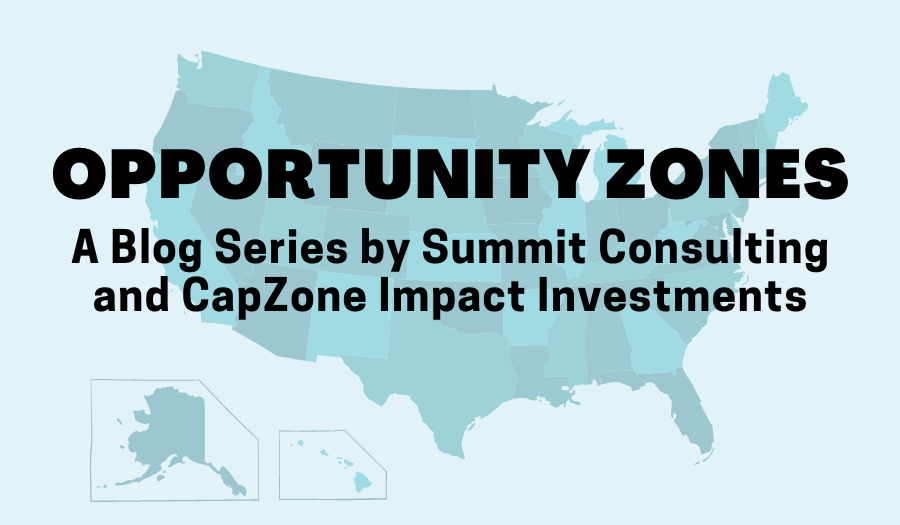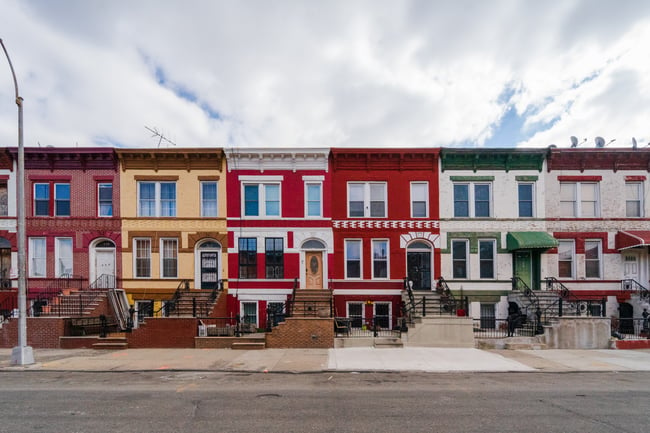Opportunity Zones Revisited: The Role of CDFIs in Driving Equitable OZ Impact
June 2, 2021 •James Hargens

With contributions by Auyon Rahman of Summit Consulting and Jonathan Ewert of CapZone Impact Investments
Disclaimer: Summit does not provide any services directly to any Community Development Finance Institution but provides consulting and analytical support to the U.S. Department of the Treasury to measure the success of CDFI Fund programs, including the Bond Guarantee Program.
In a recent article, the New York Times highlighted new research from the University of California, Berkeley examining the initial impact of Opportunity Zones (OZs) throughout the country. While a nascent analysis by the university’s own admission—the working paper only examined OZ investment for 2019—it offers some important initial takeaways regarding OZ investment flows. First, in terms of sheer volume, the working paper estimated that OZ investments reached $18.9 billion during 2019. While substantially greater than not only industry estimates, but also other federal community development programs and tax incentives, the Joint Committee on Taxation estimated 2019 OZ capital flows at $24 billion. Second, despite this significant amount of capital flow, the 16% of all designated OZs that saw investment had higher incomes, greater home values, and higher levels of educational attainment than the remaining 84%. Together, these findings lend support to those who argue that the OZ tax incentive is not working as intended and instead is driving new investment into just a few low-income communities. It is important to note that the investment data used for the working paper were generated before the IRS had issued its final OZ regulations. This meant that investors could not be certain that their investments would be legally allowed by the IRS, which perhaps contributed to the narrowness of investment activity.
While the working paper is the first private-sector initiative to use tax-return data to analyze OZ investments, it is not the first to examine what has become a major question surrounding the goals of the OZ tax incentive since its introduction in 2017: Will OZs generate widespread private investment that directly benefits low-income communities and stakeholders in all 50 states and territories? Or will the incentive accelerate fears around gentrification and displacement of existing residents? There is no single answer for such a new incentive. But questions posed by data-driven analyses such as the Berkeley working paper help renew focus on the long-term goal of OZs. In an earlier post, we detailed some of the top-down legislative actions that are focused on making the OZ incentive a major driver of an equitable recovery from the COVID-19 pandemic. What has yet to emerge is a bottom-up mechanism to ensure that community stakeholders not only have a voice in what zones and investments qualify for the tax incentive, but also a way to directly participate in the revitalization of their communities.
 Photo by Avi Werde on Unsplash
Photo by Avi Werde on Unsplash
CDFIs: The Missing Link for OZs
Community Development Financial Institutions (CDFIs) are the ideal way to activate the Biden administration’s policy goals in Opportunity Zones for several reasons. First, CDFIs are nimble and close to the communities they serve, having been an essential presence on the ground long before their importance was highlighted by the COVID-19 pandemic. Second, CDFIs generally operate as lenders instead of equity investors, providing investors with valuable origination and credit-quality analysis of businesses they work with. Finally, in addition to these important attributes, CDFIs and OZs are not only mission-aligned but also certified by the U.S. Department of the Treasury. This high governance standard ensures that CDFIs manage credit risk and maintain proper portfolio management controls.
|
With the rapid acceleration of private investment in OZs, and with CDFIs’ mission and governance alignment with the OZ incentive, it seems logical that legislative changes could reward or even mandate CDFI involvement in OZ investments moving forward. |
CDFIs typically provide debt financing to projects and businesses by pooling low-cost, long-term capital from investors that they then deploy in local communities. This model has proven very successful for CDFIs since the establishment of the CDFI Fund in 1994, as regional and national commercial banks were able to fulfill their Community Reinvestment Act requirements by investing in CDFIs directly. The last decade has seen CDFIs increasingly leverage their balance sheets with an expanding array of commercial and institutional investors, raising additional debt to drive loan portfolio growth. However, despite the growing sophistication of CDFIs across the country, they can only raise so much debt capital. This opens the door for CDFIs to explore more diverse funding sources to finance lending and programs, including Qualified Opportunity Funds (QOFs).
Early Involvement from a Select Few
While most CDFIs haven’t invested in OZ projects directly, some of the larger CDFIs started to think about OZ involvement early on. Following the release of the proposed OZ regulations in late 2018, the Local Initiatives Support Corporation (LISC), one of the largest CDFIs nationwide that has invested more than $24 billion in underserved communities since its founding in 1979, established a strategic investments team to focus on OZ activity. LISC went on to partner with the Rockefeller Foundation to provide grant funding to six cities throughout the country to establish local project pipelines and attract private OZ investment. Most notably, LISC, through its affiliate National Equity Fund (NEF), raised $25 million in OZ equity from Fifth Third Bank. The transaction, which closed in September 2020, seeks to provide housing for “missing middle” renters who earn around 80% of an area’s median income. NEF’s managing director Karen Przypyszny says the investments “are really trying to […] fill a gap that the mainstream market cannot address on its own.” The fund supports three projects that exemplify the public-private partnership, utilizing additional financing from low-income housing tax credits, new markets tax credits, and other local tax incentives like tax increment financing.
Other organizations have made direct OZ investments on their own. For example, Clearinghouse CDFI, a California-based for-profit CDFI, became a QOF itself and made multiple OZ investments in late 2019, adding several more last year. Clearinghouse CDFI manages the QOF, whose investments totaled $2.5 million at the end of 2020 and focused on minority-owned businesses, affordable housing, and commercial spaces.
 Photo by Brandon Jacoby on Unsplash
Photo by Brandon Jacoby on Unsplash
An Expanded Role for CDFIs? Debt Financing, Community Involvement, and Racial Equity
LISC’s and Clearinghouse CDFI’s approaches offer a glimpse of how more CDFIs can play a role in OZ projects going forward. As mentioned previously, CDFIs still finance the majority of their projects through debt. Even as investor interest in OZs increases and makes OZ equity more available, many projects will still benefit from debt financing as part of the capital stack. CDFIs can step in to fill this need by offering below-market-rate debt, especially if CDFI involvement in a project is treated favorably under upcoming OZ policy and regulatory updates. Furthermore, CDFIs have access to a variety of other federal funding programs through the Treasury’s CDFI Fund and other agencies, including tax credit and loan guarantee programs.
It’s important to note that CDFIs like LISC and Clearinghouse CDFI have a deep knowledge of the communities they work in. CDFIs are aware of local project pipelines and how they interface with larger community goals. Many of these projects are years in the making and require long-term commitments, key relationships with state and local government, and diligent work on the part of CDFIs to help developers and organizations secure the funding they need. This means that CDFIs are well positioned to provide the link between impact-focused OZ investors and on-the-ground projects that could benefit from equity capital.
Finally, persistent racial disparities in Black, Indigenous, and People of Color (BIPOC) communities and fears of gentrification and displacement have fueled the call for increased community wealth-building and ownership in recent years. Accordingly, CDFIs are starting to couple project investment and technical support to empower rising developers of color with training and financing. These programs also leverage CDFIs’ knowledge to connect developers with funding opportunities and could expand to connect eligible OZ projects and QOFs with BIPOC developers.
CDFIs received an unprecedented level of financial support from COVID relief legislation, roughly 10 times the usual allocation to CDFI programs. Summit is proud to have supported many of the CDFI Fund’s programs over the years as they seek to promote the growth of CDFIs. With the rapid acceleration of private investment in OZs, and with CDFIs’ mission and governance alignment with the OZ incentive, it seems logical that legislative changes could reward or even mandate CDFI involvement in the OZ investment process moving forward. This involvement could include collaboration with local stakeholders for long-term support for the investment, as well as potential community equity participation in Opportunity Zone Funds. Regardless, CDFIs’ role in promoting and activating equitable investment in underserved communities could be the missing link to help the OZ incentive achieve its community development goals.
Get Updates
Featured Articles
Categories
- affordable housing (12)
- agile (3)
- AI (4)
- budget (3)
- change management (1)
- climate resilience (5)
- cloud computing (2)
- company announcements (15)
- consumer protection (3)
- COVID-19 (7)
- data analytics (82)
- data science (1)
- executive branch (4)
- fair lending (13)
- federal credit (36)
- federal finance (7)
- federal loans (7)
- federal register (2)
- financial institutions (1)
- Form 5500 (5)
- grants (1)
- healthcare (17)
- impact investing (12)
- infrastructure (13)
- LIBOR (4)
- litigation (8)
- machine learning (2)
- mechanical turk (3)
- mission-oriented finance (7)
- modeling (9)
- mortgage finance (10)
- office culture (26)
- opioid crisis (5)
- Opportunity Finance Network (4)
- opportunity zones (12)
- partnership (15)
- pay equity (5)
- predictive analytics (15)
- press coverage (3)
- program and business modernization (7)
- program evaluation (29)
- racial and social justice (8)
- real estate (2)
- risk management (10)
- rural communities (9)
- series - loan monitoring and AI (4)
- series - transforming federal lending (3)
- strength in numbers series (9)
- summer interns (7)
- taxes (7)
- thought leadership (4)
- white paper (15)


